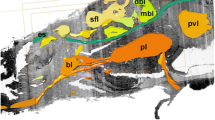Summary
-
1.
The diameter of the eyes of Nannacara anomala increases faster than the length of the body until the 5th–10th day after hatching; after this time the growth of the eyes is negatively allometric.
-
2.
The overall thickness of the retina is greatest in the temporal region of the eye for the complete period of development; it decreases toward the dorsal, central, and nasal parts and is least thick in the ventral sector. The same is true for the regional differences in the quantitative distribution of the various retinal cell classes. This means that a so-called “area” exists in the mediotemporal part of the eye of Nannacara anomala.
-
3.
During development the number of receptor cells per unit area increases to twice its original value, whereas the number of ganglion cells decreases by a half.
-
4.
The average ratio of the different cell classes of the adult retina is: 2 (receptor cells): 0.5 (horizontal cells): 2 (bipolar cells): 2 (amacrine cells): 1 (ganglion cell).
-
5.
In the “area” the density of the population of visual cells is 30% higher than in the periphery of the retina.
-
6.
When the larvae start to swim freely (5th day) there are two completely differenciated cone types (single and identical double cones) in the “area” which are arranged in a square pattern. Functioning rods are not found until the 16th day after hatching.
-
7.
The retinomotor response of single cones and rods can be observed after the 16th day.
-
8.
A temporal sequence of 6 different stages in the development of the visual cells is distinguished in the fundus of the eye. At a certain age the same stages are found as a spatial sequence in the peripheral zones of additional growth.
-
9.
The extent of the growth zones corresponding to the different stages of differenciation of the receptor cells during the course of the development of the eye is studied in reconstructions of serial sections. The growth of the visual cells is most advanced in the mediotemporal “area” and most delayed in the ventral part of the retina.
-
10.
The regional differences in the development of the retina are discussed with respect to ethological and sensory-physiological findings in young Nannacara.
Zusammenfassung
-
1.
Bis zum 5.–10. Tag nach dem. Schlüpfen wachsen die Augen von Nannacara anomala schneller als der Körper; danach wachsen die Augen negativ allometrisch.
-
2.
Die Gesamtdicke der Netzhaut ist wahrend der gesamten Entwicklung temporal am größten; sie nimmt nach dorsal, zentral and nasal ab and ist im ventralen Bereich am geringsten. Gleiches gilt für die regionale Verteilung der verschiedenen Zellklassen der Retina. Im mediotemporalen Abschnitt des Nannacara-Auges liegt daher eine „Area” vor.
-
3.
Im Verlaufe der Entwicklung wächst die Zahl der Rezeptoren pro Flächeneinheit auf das Doppelte, während sich die Zahl der Ganglienzellen auf die Hälfte des Ursprungswerts verringert.
-
4.
In der adulten Retina lautet das mittlere Zahlenverhältnis der Zellklassen : 2 (Rezeptoren) : 0,5 (Horizontalen) : 2 (Bipolaren) : 2 (Amakrinen) : 1 (Ganglienzellen).
-
5.
Die Sehzelldichte der Area ist im ausgewachsenen Auge um 30% höher als in der Peripherie.
-
6.
Zum Zeitpunkt des Freischwimmens findet man in der Area zwei voll differenzierte Zapfentypen (Einzel- und gleiche Doppelzapfen), die im Quadratmuster angeordnet sind. Funktionsfähige Stäbchen sind nicht vor dem 16. Tag nachweisbar.
-
7.
Die retinomotorische Wanderung der Einzelzapfen und Stäbchen setzt am bzw. nach dem 16. Tag der Entwicklung ein.
-
8.
Es werden 6 verschiedene Stadien der Rezeptorentwicklung in zeitlicher Abfolge nacheinander im Augenhintergrund unterschieden. Dieselben Stadien findet man auch als Zuwachszonen in der Retinaperipherie der gleichen Altersstufe.
-
9.
An räumlichen Rekonstruktionen von Serienschnitten ganzer Augen wird die Ausdehnung der den einzelnen Entwicklungsstadien entsprechenden Zuwachszonen während der Entwicklung untersucht. Die Rezeptordifferenzierung schreitet in der mediotemporalen Area am schnellsten fort and setzt in der ventralen Retina wegen des Augenspalts mit starker Verzögerung gegenüber den anderen Netzhautregionen ein.
-
10.
Die regionalen Unterschiede in der Netzhautentwicklung werden im Zusammenhang mit sinnesphysiologischen and ethologischen Beobachtungen an jungen Nannacara diskutiert.
Similar content being viewed by others
Literatur
Cajal, R. S.: Die Retina der Wirbelthiere. Wiesbaden: Bergmann 1894
Dathe, H. H.: Vergleichende Untersuchungen an der Retina mitteleuropäischer Süßwasserfische. Z. mikr.-anat. Forsch. 80, 269–319 (1969)
Foot, N. Ch.: The Masson trichomate staining methods in routine laboratory use. Stain Technol. 3, 101–110 (1933)
Hebel, R.: Entwicklung und Struktur der Retina und des Tapetum lucidum des Hundes. Ergebnisse der Anatomie, Bd. 45, S. 2. Berlin-Heidelberg-New York: Springer 1971
Kahmann, H.: Über das Vorkommen einer Fovea centralis im Knochenfischauge. Zool. Anz. 106, 49 (1934)
Kuenzer, P.: Die Auslösung der Nachfolgereaktion bei erfahrungslosen Jungfischen von Nannacara anomala (Cichlidae). Z. Tierpsychol. 25, 257–314 (1968)
Lyall, A. H.: The growth of the trout retina. Anat. J. micr. Sci. 98, 101–110 (1957)
Müller, H.: Ban und Waehstum der Netzhaut des Guppy (Lebistes reticulates). Zool. Jb. Abt. allg. Zool. u. Physiol. 63, 275–324 (1953)
Stange, G.: Persönliche Mitteilung (1974)
Wagner, H.-J.: Vergleichende Untersuchungen über das Muster von Sehzellen und Horizontalen in der Teleostier-Retina (Pisces). Z. Morph. Tiere 72, 77–130 (1972)
Wagner, H.-J.: Die nervösen Netzhautelemente von Nannacara anomala (Cichlidae, Teleostei). I. Darstellung durch Silberimprägnation. Z. Zellforsch. 137, 63–86 (1973)
Witkovsky, P., Dowling, J. E.: Synaptic relationships in the plexiform layers of carp retina. Z. Zellforsch. 100, 60–82 (1969)
Author information
Authors and Affiliations
Additional information
Den Herren Prof. Dr. E. Lindner (Regensburg) und Prof. Dr. P. Kuenzer (Göttin-gen) danke ich für die anregenden Diskussionen bei der Entstehung der Arbeit.
Der experimentelle Teil der Arbeit entstand im II. Zoologischen Institut der Universität Göttingen (Direktor: Prof. Dr. Peter Ax).
Rights and permissions
About this article
Cite this article
Wagner, HJ. Die entwicklung der netzhaut von Nannacara anomala (Regan) (Cichlidae, Teleostei) mit besonderer Berücksichtigung regionaler Differenzierungsunterschiede. Z. Morph. Tiere 79, 113–131 (1974). https://doi.org/10.1007/BF00298778
Received:
Issue Date:
DOI: https://doi.org/10.1007/BF00298778




